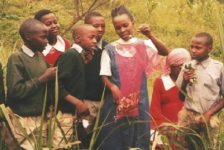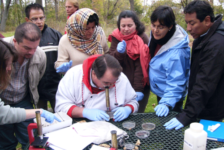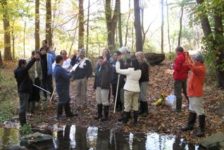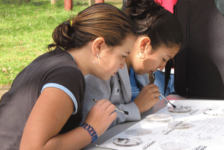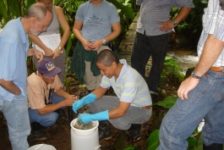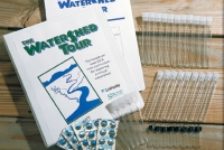National Geographic reported on the recent expedition to Peru by the Amazon Center for Environmental Education and Research (ACEER) and Stroud Water Research Center. The team used leaf packs and direct collection of macroinvertebrates from stream to assess the health of the ecosystems.
According to the team, “When correlated with our previous benthic surveys this simple leaf pack tool is a powerful way to assess ongoing aquatic biodiversity. In our study, the indicators of highest water quality are insects known as stoneflies, mayflies, and caddisflies. When we find large populations of midge larvae called chironomids it is a pretty sure sign that the stream is under stress or severely degraded.”
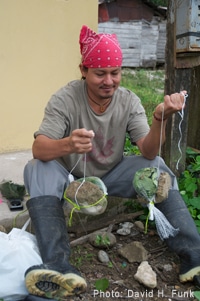
Therany Gonzalez-Ojeda, ACEER Director of Field Operations in Peru, with leaf packs ready for placement in a stream.
Read the full article on the National Geographic blog.
The objective of the ACEER collaboration is to create a comprehensive water-quality baseline along the new road from Cusco to Puerto Maldonado, part of the just-completed Transoceanic Highway, which connects the interior of Brazil to Peru’s Pacific Ocean ports. The 2,600-kilometer highway has opened previously remote parts of the interior to rapid population growth, development, and resource extraction, the impacts of which could have worldwide consequences.
In September 2011, Stroud Center Director Dr. Bern Sweeney and Leaf Pack Network Administrator Christina Medved led a weeklong program in the Amazonian headwaters of Peru.
Their goal was to use the Leaf Pack Kit and the Leaf Pack Network® website created by the Stroud Center’s scientists and educators to teach local citizens how to monitor the quality of their water and assess the degradation in their streams.
In two packed workshops, Sweeney and Medved introduced the new Spanish-language version of Leaf Pack — the latest development in their ongoing efforts to expand the program across Latin America and ultimately around the world.



